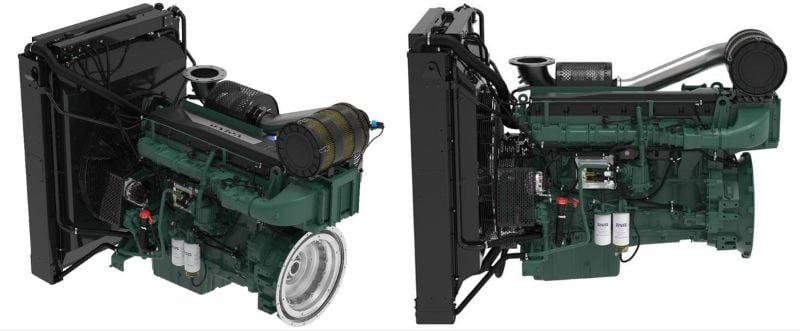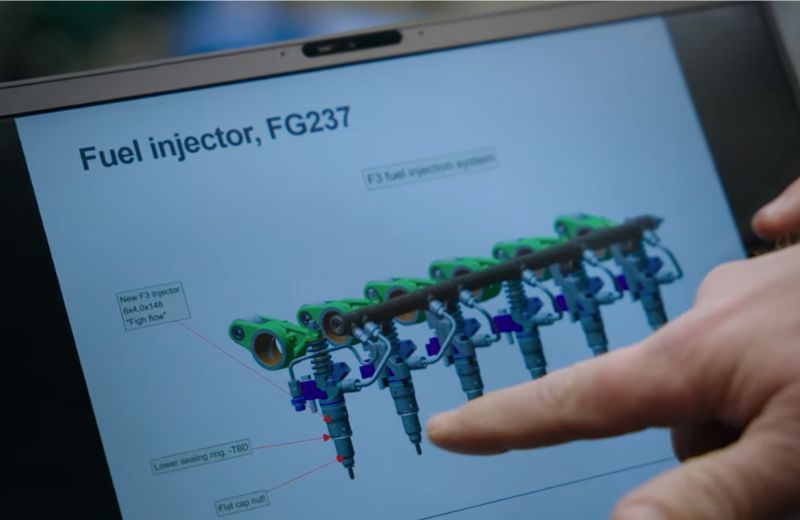Inside Volvo Penta’s Powerful Engine for Industrial Generators
With improved power density via dual-stage turbochargers and heavy-duty steel pistons, Volvo Penta’s D17 genset engine supplies reliable backup power for industrial equipment.
The most advanced engine in Volvo Penta’s fuel-efficient generator set lineup will soon hit the North American market. The 706 kW D17—developed by Volvo Group’s marine and industrial engine subsidiary—delivers up to 5% less fuel consumption per kWh than its predecessor, the D16, and other similar designs.
D17 engine. Image used courtesy of Volvo Penta
The 17.26-liter diesel engine incorporates the latest combustion technology advancements, chiefly an upgraded fuel-injection system with electronic unit injectors and a common-rail design to reduce exhaust emissions. To improve the power density, Volvo Penta’s engineers added dual-stage turbochargers and heavy-duty steel pistons, which allow it to power a range of electrical gensets, from prime 50 Hz systems (up to 758 kVA) to standby 60 Hz systems (up to 881 kVA).
The in-line six-cylinder system offers a high-power alternative to other Tier 3 and Tier 4 engines in the same class. With 1,500/1,800 revolutions per minute (rpm), the dual-speed engine is ideal in applications needing continuous availability of backup electrical power, such as equipment used in data centers, hospitals, and airports.
With minimal maintenance, D17 enables a higher uptime for the systems it targets: permanent standby and mobile gensets. (For context, standby or emergency power generators are usually installed in stationary locations to supply backup power during outages; prime generators serve as the main power source for equipment or other operations.)
The engine is certified with the U.S. Environmental Protection Agency’s Tier 2 stationary emergency regulations, meaning it can supply a few hours of backup power for markets requiring the highest standards for reliability. The D17 also complies with the ISO 8528 G3 load acceptance standard, meeting power demands quickly in blackouts.
D17 engine. Image used courtesy of Volvo Group
In the coming months, the first units will be delivered to Blue Star Power Systems, a Minnesota-based company that integrates power generation systems for industrial customers.
Improved Power-to-Weight Ratio With Fewer Emissions
The compact D17 builds on the design of the 16-liter Volvo D16 engine, first released in 2005 for premium line-haul fleets and other heavy-duty vehicles. The inline six-cylinder block provided a starting ground for the new model, which matches the D16’s footprint but consumes less fuel.
One of D17’s key points is its low-weight architecture, which allows smooth operation with low vibration and noise output. This benefit comes alongside enhanced volume, as Volvo Penta’s engineers added a larger bore engine to increase the maximum standby power by 10% compared to the D16 at 1,800 rpm.
D17 industrial power generation engine. Image used courtesy of Volvo Penta
D17’s common-rail injection system follows a growing trend in modern diesel engines. Manufacturers often prefer this design because it provides electronically controlled precision in the combustion process.
In a typical common-rail injection system, the fuel is stored at a variable pressure in a cylinder linked to the fuel injectors. Unlike conventional mechanical systems with only a fuel pump to control the pressure, timing, and quantity, common-rail systems combine this function with high-pressure injectors. Through a programmable control module, operators can readily adjust injections for better fuel consumption and emission control.
The D17 engine uses a common-rail fuel injection system. Image used courtesy of Volvo Penta
The D17 also features an extended 1,000-hour service and oil change interval, low heat injection, and common spare parts. The optional cooling package further minimizes noise emissions and fuel consumption with an air filter and a fixed or viscous fan.
Like other Volvo Penta engines, the D17 can run on hydro-treated vegetable oil as an alternative fuel source. The company continues to explore technologies in this domain, including an effort to develop a natural gas version of the D17. It also recently expanded into battery energy storage systems.










